The Study of Synergistic Changes in Extreme Cold and Warm Events in the Sanjiang Plain
Abstract
:1. Introduction
2. Materials and Methods
2.1. Relevant Definitions of Extreme Events
2.2. Overview of the Study Area
2.3. Source of Research Data
2.4. Methods of Analysis
3. Results
3.1. Spatial Distribution of the Number of Extreme Events
3.2. Inter-Annual Variation in the Number of Extreme Events
3.3. The Spatiotemporal Distribution of the Rate of Change in Extreme Events
3.4. Discrete Degree Analysis of Extreme Events
4. Discussion
5. Conclusions
Author Contributions
Funding
Institutional Review Board Statement
Informed Consent Statement
Data Availability Statement
Acknowledgments
Conflicts of Interest
References
- Michelozzi, P.; Donato, D.F. IPCC Sixth Assessment Report: Stopping climate change to save our planet. Epidemiol. Prev. 2021, 45, 227–229. [Google Scholar] [CrossRef] [PubMed]
- Sun, J.; Liu, T.; Xie, S.; Xiao, J.; Huang, L.; Wan, Z.; Zhong, K. Will extreme temperature events emerge earlier under global warming? Atmos. Res. 2023, 288, 106745. [Google Scholar] [CrossRef]
- Zeng, N.; Ding, Y.; Pan, J.; Wang, H.; Gregg, J. Climate Change—The Chinese Challenge. Science 2008, 319, 730–731. [Google Scholar] [CrossRef] [PubMed]
- Liu, Z.; Yang, X.; Chen, F.; Wang, E. The effects of past climate change on the northern limits of maize planting in Northeast China. Clim. Chang. 2013, 117, 891–902. [Google Scholar] [CrossRef]
- Huang, J.; Jiang, J.; Wang, J.; Hou, L. Crop Diversification in Coping with Extreme Weather Events in China. J. Integr. Agric. 2013, 13, 677–686. [Google Scholar] [CrossRef]
- Jie, L.; Xiaofeng, X.; Hui, L. An empirical study on the impact of extreme weather and climate events on agricultural economic output in China. Chin. Sci. Earth Sci. 2012, 42, 1076–1082. [Google Scholar]
- Cheng, P.; Peng, L.; Hao, J.; Li, S.; Zhang, C.; Dou, L.; Fu, W.; Yang, F.; Hao, J. Short-term effects of ambient temperature on preterm birth: A time-series analysis in Xuzhou, China. Environ. Sci. Pollut. Res. Int. 2020, 28, 12406–12413. [Google Scholar] [CrossRef]
- Guo, J.; Ruan, Y.; Wang, Y.; Wang, H.; Ma, S.; Wan, X.; Zhou, X.; Tang, Z.; He, Y.; Zou, Z.; et al. Maternal Exposure to Extreme Cold Events and Risk of Congenital Heart Defects: A Large Multicenter Study in China. Environ. Sci. Technol. 2024, 58, 3737–3746. [Google Scholar] [CrossRef]
- Zhai, P.; Pan, X. Trends in temperature extremes during 1951–1999 in China. Geophys. Res. Lett. 2003, 30, 1913. [Google Scholar] [CrossRef]
- You, Q.; Jiang, Z.; Kong, L.; Wu, Z.; Bao, Y.; Kang, S.; Pepin, N. A comparison of heat wave climatologies and trends in China based on multiple definitions. Clim. Dyn. 2017, 48, 3975–3989. [Google Scholar] [CrossRef]
- Gao, W.; Duan, K.; Li, S. Spatial-temporal variations in cold surge events in northern China during the period 1960–2016. J. Geogr. Sci. 2019, 29, 971–983. [Google Scholar] [CrossRef]
- Zhu, Y.; Song, F.; Guo, D. Interdecadal changes in the frequency of winter extreme cold events in North China during 1989–2021. Atmos. Ocean. Sci. Lett. 2024, 17, 100468. [Google Scholar] [CrossRef]
- Zhen, L. Extreme Cold Events and Interdiural Temperature Variation at the Regional Scale in China under Global Warming Background. Ph.D. Thesis, University of Chinese Academy of Sciences, Beijing, China, June 2020. [Google Scholar]
- Li, X.; Zhang, Y.-J.; Gao, H.; Ding, T. Extreme cold wave in early November 2021 in China and the influences from the meridional pressure gradient over East Asia. Adv. Clim. Chang. Res. 2022, 13, 797–802. [Google Scholar] [CrossRef]
- Liao, Z.; Zhai, P.; Chen, Y.; Lu, H. Differing mechanisms for the 2008 and 2016 wintertime cold events in southern China. Int. J. Clim. 2020, 40, 4944–4955. [Google Scholar] [CrossRef]
- Ma, S.; Zhu, C. Extreme Cold Wave over East Asia in January 2016: A Possible Response to the Larger Internal Atmospheric Variability Induced by Arctic Warming. J. Clim. 2019, 32, 1203–1216. [Google Scholar] [CrossRef]
- Zhu, R.; Wu, X.; Zhang, W.; He, J.; Qin, Y.; Li, Z.; Shen, Y. Seasonally extreme temperature events accelerate in arid northwestern China during 1979-2018. Atmos. Res. 2024, 300, 107230. [Google Scholar] [CrossRef]
- Lin, X.; Wang, Y.; Song, L. Variation of temperature extremes in wintertime over Beijing-Tianjin-Hebei region in the era of sharp decline of Arctic sea ice. Atmos. Res. 2024, 297, 107113. [Google Scholar] [CrossRef]
- Johnson, N.C.; Xie, S.-P.; Kosaka, Y.; Li, X. Increasing occurrence of cold and warm extremes during the recent global warming slowdown. Nat. Commun. 2018, 9, 1724. [Google Scholar] [CrossRef]
- Casson, N.J.; Contosta, A.R.; Burakowski, E.A.; Campbell, J.L.; Crandall, M.S.; Creed, I.F.; Eimers, M.C.; Garlick, S.; Lutz, D.A.; Morison, M.Q.; et al. Winter Weather Whiplash: Impacts of Meteorological Events Misaligned with Natural and Human Systems in Seasonally Snow-Covered Regions. Earth’s Future 2019, 7, 1434–1450. [Google Scholar] [CrossRef]
- Liu, J.; Dietz, T.; Carpenter, S.R.; Alberti, M.; Folke, C.; Moran, E.; Pell, A.N.; Deadman, P.; Kratz, T.; Lubchenco, J.; et al. Complexity of Coupled Human and Natural Systems. Science 2007, 317, 1513–1516. [Google Scholar] [CrossRef]
- Yang, Z. Study on the Evolution and Prediction of Cultivated Land Productivity in Sanjiang Plain. Master’s Thesis, Northeast Agricultural University, Harbin, China, 2020. [Google Scholar]
- Ge, Q.; Wang, H.; Dai, J. Shifts in spring phenophases, frost events and frost risk for woody plants in temperate China. Clim. Res. 2013, 57, 249–258. [Google Scholar] [CrossRef]
- Liu, Z.; Yang, X.; Wang, W.; Li, K.; Zhang, X. Characteristics of agricultural climate resources in three provinces of Northeast China under global climate change. Chin. J. Appl. Ecol. 2009, 20, 2199–2206. [Google Scholar]
- Lu, N.; Wilske, B.; Ni, J.; John, R.; Chen, J. Climate change in Inner Mongolia from 1955 to 2005—Trends at regional, biome and local scales. Environ. Res. Lett. 2009, 4, 045006. [Google Scholar] [CrossRef]
- Wanyama, D.; Bunting, E.L.; Weil, N.; Keellings, D. Delineating and characterizing changes in heat wave events across the United States climate regions. Clim. Chang. 2023, 176, 6. [Google Scholar] [CrossRef]
- Della-Marta, P.M.; Haylock, M.R.; Luterbacher, J.; Wanner, H. Doubled length of western European summer heat waves since 1880. J. Geophys. Res. Atmos. 2007, 112, D15103. [Google Scholar] [CrossRef]
- Asia faces weather whiplash as Earth warms. Nature 2023, 614, 198. [CrossRef] [PubMed]
- Francis, J.A.; Skific, N.; Zobel, Z. Weather whiplash events in Europe and North Atlantic assessed as continental-scale atmospheric regime shifts. npj Clim. Atmos. Sci. 2023, 6, 216. [Google Scholar] [CrossRef]
- Chen, Y.; Liao, Z.; Zhai, P. Coincidence of increasingly volatile winters in China with Arctic seaice loss during 1980–2018. Environ. Res. Lett. 2019, 14, 124076. [Google Scholar] [CrossRef]
- Baoqi, L. The Law of Runoff Evoluton in Sanjiang Plain under Freezing-Thawing Soil Conditions. Ph.D. Thesis, China Institude of Water Resource &Hydropower Reseach(IWHR), Beijing, China, June 2020. [Google Scholar]
- Ma, S.; Wang, Q.; Wang, C.; Huo, Z. The risk division on climate and economic loss of maize chilling damage in Northeast China. Geogr. Res. 2008, 27, 1169–1177. [Google Scholar] [CrossRef]
- Moore, T.R.; Matthews, H.D.; Simmons, C.; Leduc, M. Quantifying Changes in Extreme Weather Events in Response to Warmer Global Temperature. Atmos. Ocean 2015, 53, 412–425. [Google Scholar] [CrossRef]
- Liu, J.; Du, B.; Sheng, L.; Tian, X. Dynamic patterns of change in marshes in the Sanjiang Plain and their influential factors. Adv. Water Sci. 2017, 28, 22–31. [Google Scholar] [CrossRef]
- Xu, M.; Chang, C.P.; Fu, C.; Qi, Y.; Robock, A.; Robinson, D.; Zhang, H. Steady decline of east Asian monsoon winds, 1969–2000: Evidence from direct ground measurements of wind speed. J. Geophys. Res. Atmos. 2006, 111, 24111. [Google Scholar] [CrossRef]
- Bartier, P.M.; Keller, C. Multivariate interpolation to incorporate thematic surface data using inverse distance weighting (IDW). Comput. Geosci. 1996, 22, 795–799. [Google Scholar] [CrossRef]
- Xueliang, W.; Hongyuan, L.; Rensheng, C.; Junfeng, L.; Guohua, L.; Chuntan, H. Runoff Evolution Characteristics and Driving Factors of Yellow River Above Lanzhou Station from 1956 to 2020 under Changing Environment. Adv. Earth Sci. 2022, 37, 726–741. [Google Scholar]
- Ding, T.; Gao, H.; Yuan, Y. The dominant invading paths of extreme cold surges and the invasion probabilities in China. Atmos. Sci. Lett. 2020, 21. [Google Scholar] [CrossRef]
- Liu, F.; Chen, S.; Dong, P.; Peng, J. Spatial and temporal variability of water discharge in the Yellow River Basin over the past 60 years. J. Geogr. Sci. 2012, 22, 1013–1033. [Google Scholar] [CrossRef]
- Ning, G.; Luo, M.; Zhang, W.; Liu, Z.; Wang, S.; Gao, T. Rising risks of compound extreme heat-precipitation events in China. Int. J. Clim. 2022, 42, 5785–5795. [Google Scholar] [CrossRef]
- Dai, H.; Chen, G.; Wu, J.; Yang, L.; Du, W. The rate of warming is slowing and temperature is showing sharp changes in middle and high latitude regions. Arid. Zone Res. 2020, 37, 275–281. [Google Scholar] [CrossRef]
- Santer, B.D.; Bonfils, C.; Painter, J.F.; Zelinka, M.D.; Mears, C.; Solomon, S.; Schmidt, G.A.; Fyfe, J.C.; Cole, J.N.S.; Nazarenko, L.; et al. Volcanic contribution to decadal changes in tropospheric temperature. Nat. Geosci. 2014, 7, 185–189. [Google Scholar] [CrossRef]
- Drijfhout, S.S.; Blaker, A.T.; Josey, S.A.; Nurser, A.J.G.; Sinha, B.; Balmaseda, M.A. Surface warming hiatus caused by increased heat uptake across multiple ocean basins. Geophys. Res. Lett. 2014, 41, 7868–7874. [Google Scholar] [CrossRef]
- Haibo, D. Research on the Extreme Climate Events over Northeast China under Global Climate Change. Ph.D. Thesis, Northeast Normal University, Changchun, China, May 2015. [Google Scholar]
- Khan, M.; Bhattarai, R.; Chen, L. Assessment of Deadly Heat Stress and Extreme Cold Events in the Upper Midwestern United States. Atmosphere 2024, 15, 614. [Google Scholar] [CrossRef]
- Shang, Z.; Chen, G.; Tang, X. Characteristics of cold events in the eastern China: Perspective from five metropolitan regions. Int. J. Clim. 2024, 44, 2505–2518. [Google Scholar] [CrossRef]
- GarcíaBurgos, M.; Ayarzagüena, B.; Barriopedro, D.; GarcíaHerrera, R. Jet Configurations Leading to Extreme Winter Temperatures Over Europe. J. Geophys. Res. Atmos. 2023, 128, e2023JD039304. [Google Scholar] [CrossRef]
- Ladwig, L.M.; Chandler, J.L.; Guiden, P.W.; Henn, J.J. Extreme winter warm event causes exceptionally early bud break for many woody species. Ecosphere 2019, 10, e02542. [Google Scholar] [CrossRef]
- Yao, Y.; Zhuo, W.; Gong, Z.; Luo, B.; Luo, D.; Zheng, F.; Zhong, L.; Huang, F.; Ma, S.; Zhu, C.; et al. Extreme Cold Events in North America and Eurasia in November–December 2022: A Potential Vorticity Gradient Perspective. Adv. Atmos. Sci. 2023, 40, 953–962. [Google Scholar] [CrossRef]
- Zhang, X.; Fu, Y.; Han, Z.; Overland, J.E.; Rinke, A.; Tang, H.; Vihma, T.; Wang, M. Extreme Cold Events from East Asia to North America in Winter 2020/21: Comparisons, Causes, and Future Implications. Adv. Atmos. Sci. 2021, 39, 553–565. [Google Scholar] [CrossRef]
- Zheng, F.; Yuan, Y.; Ding, Y.; Li, K.; Fang, X.; Zhao, Y.; Sun, Y.; Zhu, J.; Ke, Z.; Wang, J.; et al. The 2020/21 Extremely Cold Winter in China Influenced by the Synergistic Effect of La Niña and Warm Arctic. Adv. Atmos. Sci. 2021, 39, 546–552. [Google Scholar] [CrossRef]
- Yu, L.; Liu, Y.; Liu, T.; Yan, F. Impact of recent vegetation greening on temperature and precipitation over China. Agric. For. Meteorol. 2020, 295, 108197. [Google Scholar] [CrossRef]
- Luo, M.; Lau, N. Increasing Human-Perceived Heat Stress Risks Exacerbated by Urbanization in China: A Comparative Study Based on Multiple Metrics. Earth’s Future 2021, 9, e2020EF001848. [Google Scholar] [CrossRef]
- McCusker, K.E.; Fyfe, J.C.; Sigmond, M. Twenty-five winters of unexpected Eurasian cooling unlikely due to Arctic sea-ice loss. Nat. Geosci. 2016, 9, 838–842. [Google Scholar] [CrossRef]
- Gulev, S.K.; Thorne, P.W.; Ahn, J.; Dentener, F.J.; Domingues, C.M.; Gerland, S.; Gong, D.; Kaufman, D.S.; Nnamchi, H.C.; Quaas, J.; et al. Changing state of the climate system. In Climate Change 2021: The Physical Science Basis; Contribution of Working Group I to the Sixth Assessment Report of the Intergovernmental Panel on Climate Change; Masson-Delmotte, V., Zhai, P., Pirani, A., Connors, S.L., Péan, C., Berger, S., Caud, N., Chen, Y., Goldfarb, L., Gomis, M.I., et al., Eds.; Cambridge University Press: Cambridge, UK; New York, NY, USA, 2021; pp. 287–422. [Google Scholar] [CrossRef]
- Keellings, D.; Moradkhani, H. Spatiotemporal Evolution of Heat Wave Severity and Coverage Across the United States. Geophys. Res. Lett. 2020, 47, e2020GL087097. [Google Scholar] [CrossRef]
- Hu, W.; Zhang, G.; Zeng, G.; Li, Z. Changes in Extreme Low Temperature Events over Northern China under 1.5 °C and 2.0 °C Warmer Future Scenarios. Atmosphere 2018, 10, 1. [Google Scholar] [CrossRef]
- Kug, J.-S.; Jeong, J.-H.; Jang, Y.-S.; Kim, B.-M.; Folland, C.K.; Min, S.-K.; Son, S.-W. Two distinct influences of Arctic warming on cold winters over North America and East Asia. Nat. Geosci. 2015, 8, 759–762. [Google Scholar] [CrossRef]
- Hanna, E.; Hall, R.J.; Overland, J.E. Can Arctic warming influence UK extreme weather? Weather 2017, 72, 346–352. [Google Scholar] [CrossRef]
- Cohen, J. An observational analysis: Tropical relative to Arctic influence on midlatitude weather in the era of Arctic amplification. Geophys. Res. Lett. 2016, 43, 5287–5294. [Google Scholar] [CrossRef]
- Cohen, J.; Pfeiffer, K.; Francis, J.A. Warm Arctic episodes linked with increased frequency of extreme winter weather in the United States. Nat. Commun. 2018, 9, 869. [Google Scholar] [CrossRef]
- Overland, J.E.; Dethloff, K.; Francis, J.A.; Hall, R.J.; Hanna, E.; Kim, S.-J.; Screen, J.A.; Shepherd, T.G.; Vihma, T. Nonlinear response of mid-latitude weather to the changing Arctic. Nat. Clim. Chang. 2016, 6, 992–999. [Google Scholar] [CrossRef]
- Zarzycki, C.M. Projecting Changes in Societally Impactful Northeastern, U.S. Snowstorms. Geophys. Res. Lett. 2018, 45, 12067–12075. [Google Scholar] [CrossRef]
- Warner, J.L.; Screen, J.A.; Scaife, A.A. Links between Barents-Kara Sea Ice and the Extratropical Atmospheric Circulation Explained by Internal Variability and Tropical Forcing. Geophys. Res. Lett. 2020, 47, e2019GL085679. [Google Scholar] [CrossRef]
- Ma, S.; Zhu, C.; Liu, B.; Zhou, T.; Ding, Y.; Orsolini, Y.J. Polarized Response of East Asian Winter Temperature Extremes in the Era of Arctic Warming. J. Clim. 2018, 31, 5543–5557. [Google Scholar] [CrossRef]
- Shepherd, T.G. Atmospheric circulation as a source of uncertainty in climate change projections. Nat. Geosci. 2014, 7, 703–708. [Google Scholar] [CrossRef]


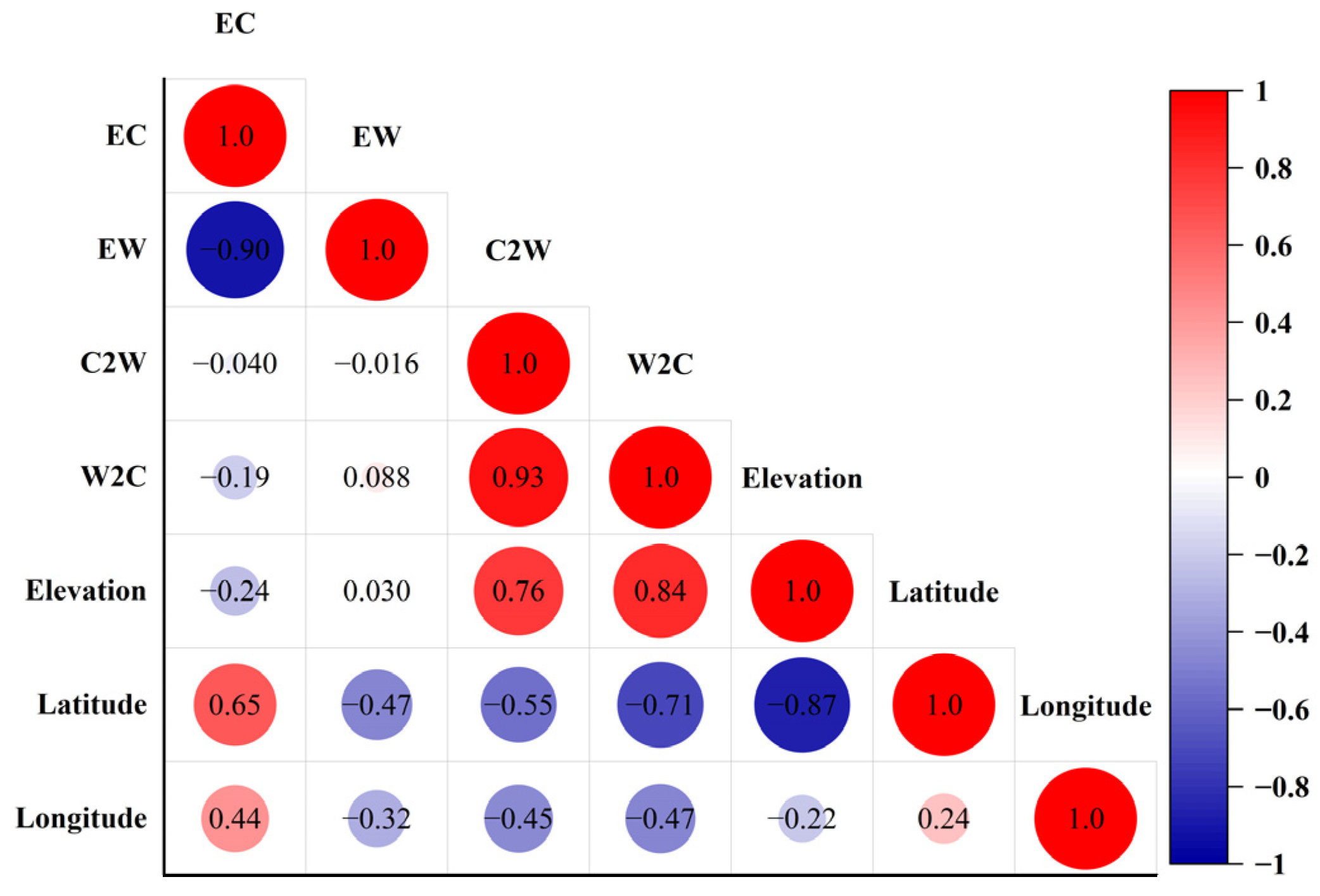

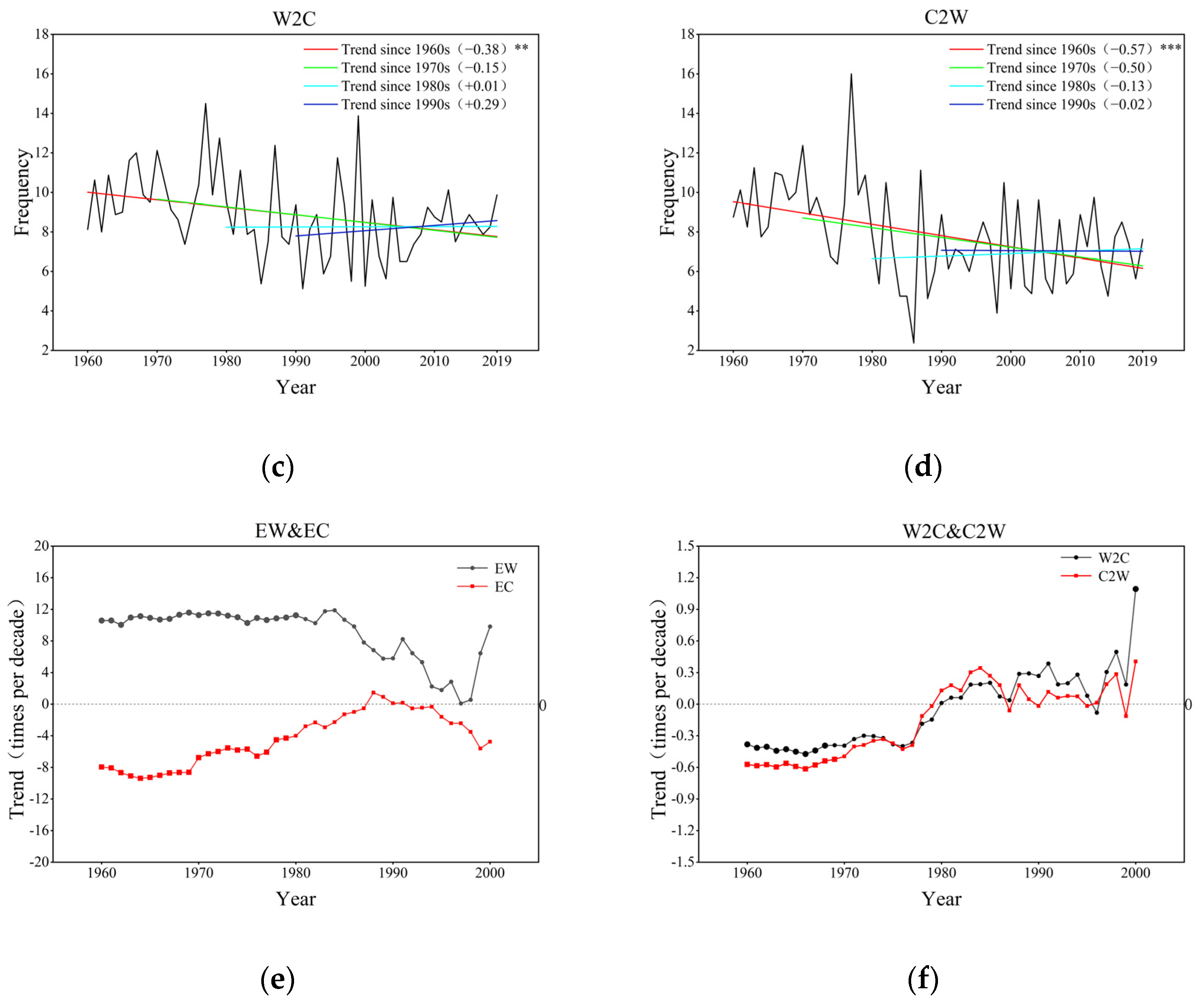
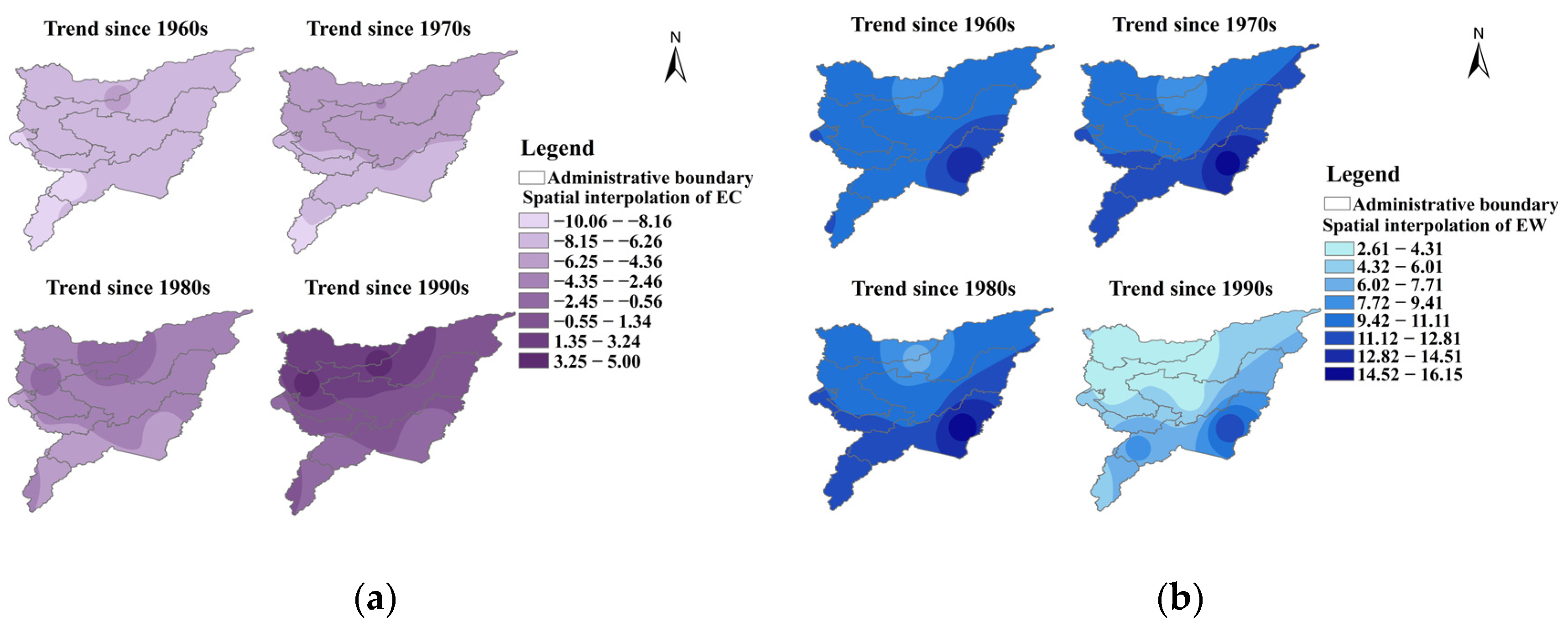
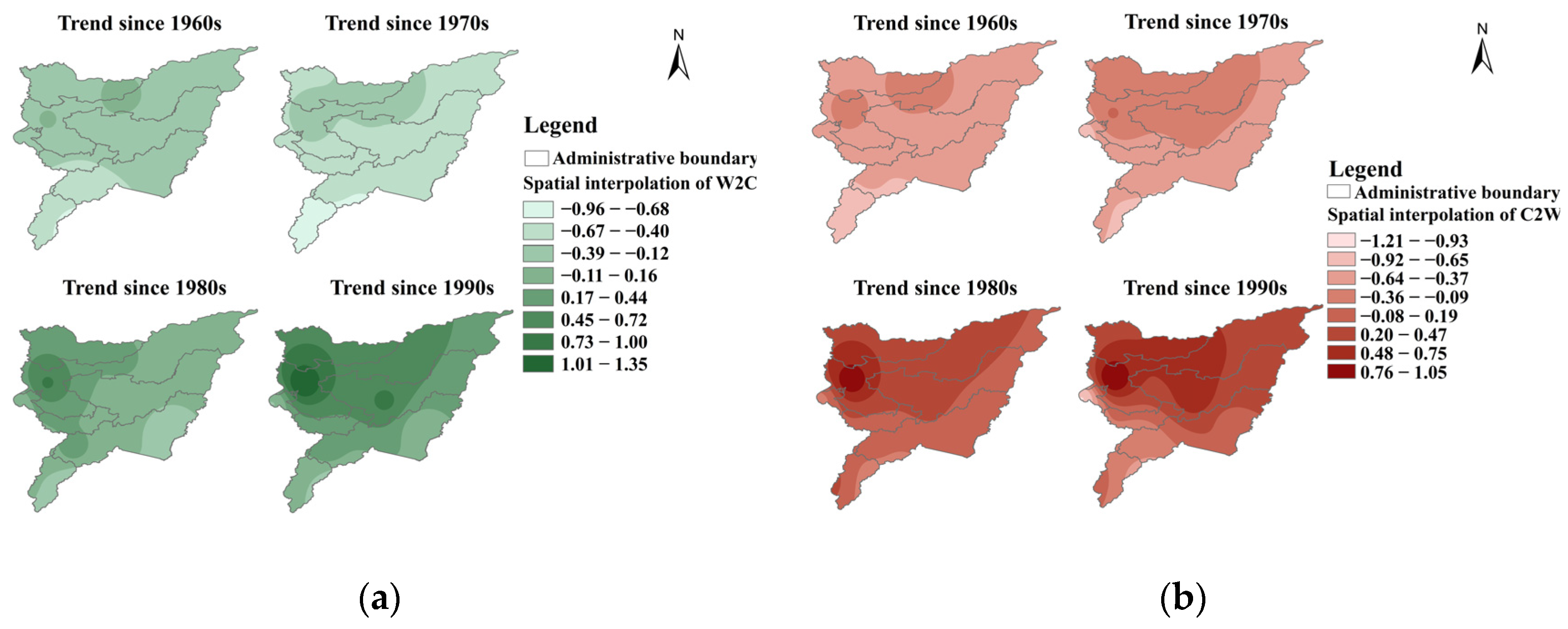

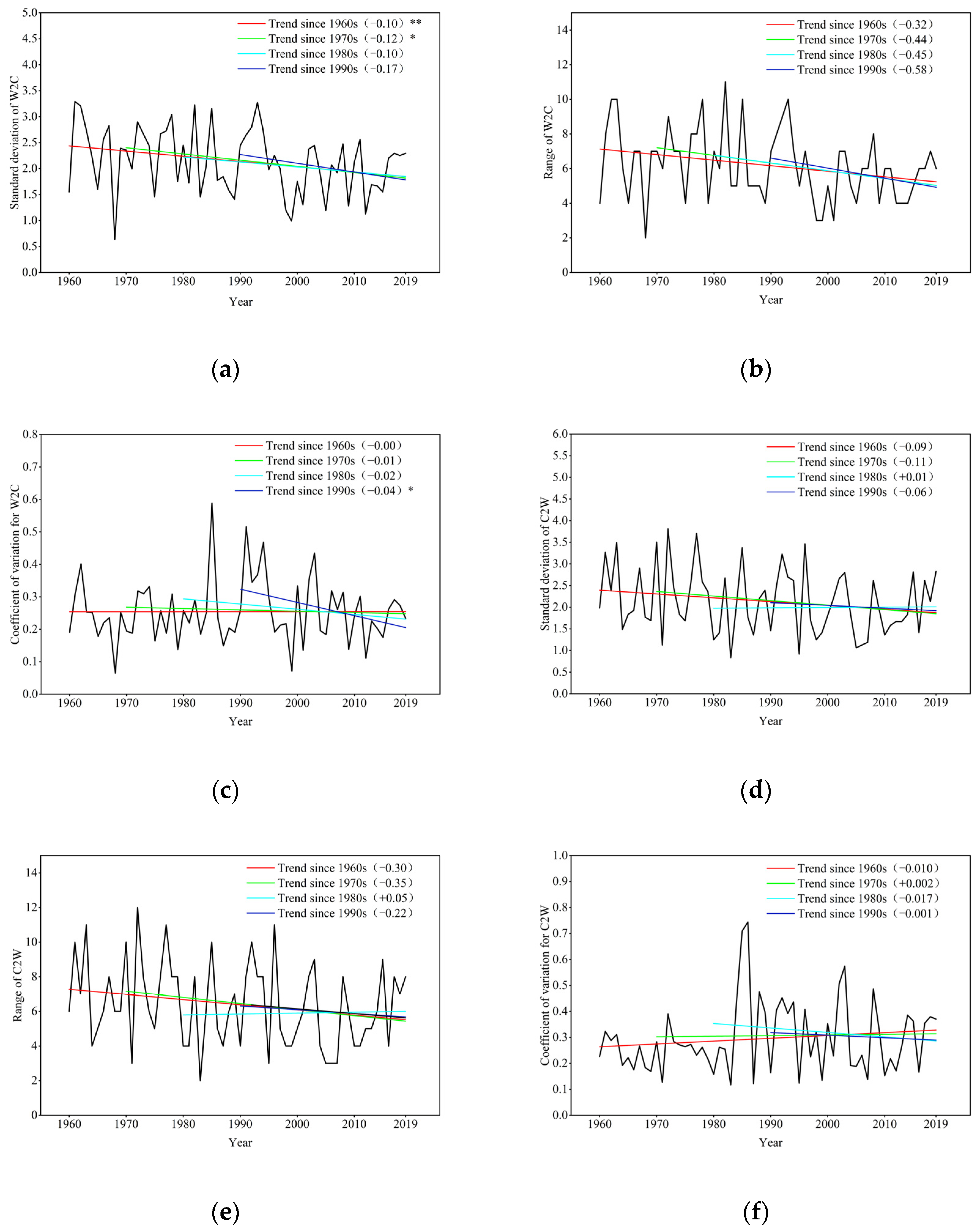
| Station | Station Code | Longitude (°) | Latitude (°) | Elevation (m) | Date Series (Year) |
|---|---|---|---|---|---|
| Fujin | 50,788 | 131.98 | 47.23 | 66.40 | 1960–2019 |
| Jiamusi | 50,873 | 130.30 | 46.78 | 82.00 | 1960–2019 |
| Yilan | 50,877 | 129.58 | 46.30 | 100.10 | 1960–2019 |
| Baoqing | 50,888 | 132.17 | 46.38 | 79.60 | 1960–2019 |
| Jixi | 50,978 | 130.92 | 45.30 | 272.50 | 1960–2019 |
| Hulin | 50,983 | 132.97 | 45.77 | 102.20 | 1960–2019 |
| Mudanjiang | 54,094 | 129.67 | 44.50 | 307.70 | 1960–2019 |
| Suifenhe | 54,096 | 131.17 | 44.38 | 569.80 | 1960–2019 |
Disclaimer/Publisher’s Note: The statements, opinions and data contained in all publications are solely those of the individual author(s) and contributor(s) and not of MDPI and/or the editor(s). MDPI and/or the editor(s) disclaim responsibility for any injury to people or property resulting from any ideas, methods, instructions or products referred to in the content. |
© 2024 by the authors. Licensee MDPI, Basel, Switzerland. This article is an open access article distributed under the terms and conditions of the Creative Commons Attribution (CC BY) license (https://creativecommons.org/licenses/by/4.0/).
Share and Cite
Li, B.; Chi, Y.; Zhou, H.; Zhang, S.; Lu, Y. The Study of Synergistic Changes in Extreme Cold and Warm Events in the Sanjiang Plain. Atmosphere 2024, 15, 1092. https://doi.org/10.3390/atmos15091092
Li B, Chi Y, Zhou H, Zhang S, Lu Y. The Study of Synergistic Changes in Extreme Cold and Warm Events in the Sanjiang Plain. Atmosphere. 2024; 15(9):1092. https://doi.org/10.3390/atmos15091092
Chicago/Turabian StyleLi, Baoqi, Yanyu Chi, Hang Zhou, Shaoxiong Zhang, and Yao Lu. 2024. "The Study of Synergistic Changes in Extreme Cold and Warm Events in the Sanjiang Plain" Atmosphere 15, no. 9: 1092. https://doi.org/10.3390/atmos15091092





